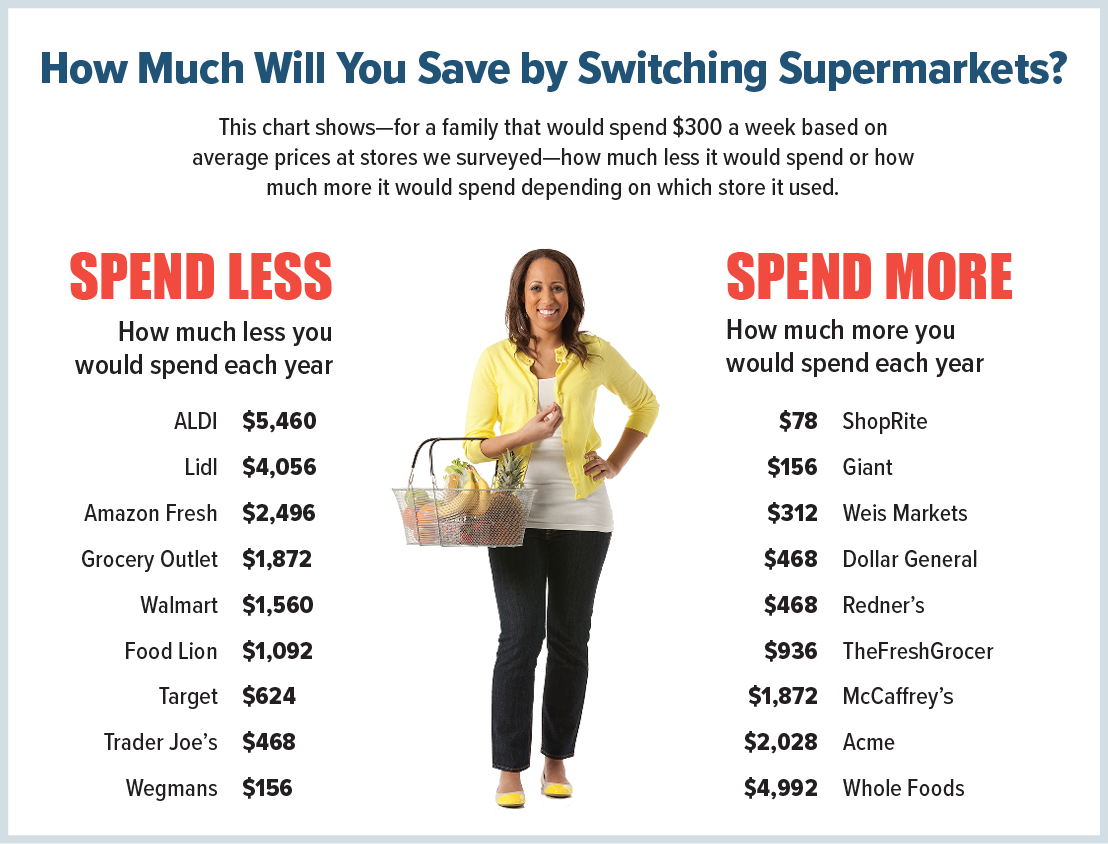Which Grocery Stores Offer the Best Prices and Quality?
Last updated November 2025

Our latest comparison of Delaware Valley area supermarkets’ prices and quality is in the bag. Consumers’ Checkbook researchers shopped stores using a 150-item list to compare prices. To evaluate stores on quality of products and service, we surveyed our members. The figures below summarize our findings; for details, see our Ratings Tables. Here’s what we found:
Wegmans is still a winner.
Wegmans continues its slow-but-steady East Coast expansion and now has 11 stores in the Delaware Valley area. Since opening its first area location in 2003, the Rochester-based chain has consistently earned high ratings from its customers for quality. In our latest survey, 85 percent of its customers judged it “superior” on each of our survey questions on produce, meat, and overall quality.
Although Wegmans’ prices aren’t among the lowest in the region, it remains competitive. Its prices were about two percent lower than average prices at Giant and ShopRite, four percent lower than Redner’s, about 12 percent lower than Acme and McCaffrey’s, and 25 percent lower than Whole Foods.
McCaffrey’s gets raves but isn’t a low-cost option.
The locally owned small chain ranked among the area’s best grocery options for quality, with 87 percent of its surveyed customers judging it “superior” overall, 90 percent rating it “superior” for produce, and 88 percent rating it tops for meat. But McCaffrey’s prices were about 12 percent higher than the all-store average.
ALDI and Lidl offer the biggest savings.
German-based discounters ALDI and Lidl, ubiquitous in most of western Europe, continue to expand their U.S. footprints. These chains focus on low costs, and our survey found them quite inexpensive: For our shopping list, ALDI’s prices were 35 percent lower than the all-store average, and Lidl’s were 26 percent lower. ALDI’s per-unit prices were even lower than BJ’s, Costco, and Sam’s Club.
These savings are partly explained by ALDI’s and Lidl’s smaller-format stores, which have much lower overhead costs than conventional supermarkets.
ALDI and Lidl also benefit from different expectations. Shoppers at Acme, ShopRite, Walmart, etc., expect to always find their favorite brands in a variety of sizes on the shelves. Like Trader Joe’s, ALDI and Lidl carry mostly their own brands, not national-brand products. ALDI and Lidl do offer some national brands, but overall, selection is limited. In other words, you’ll find some of the most popular brands (Coke, Heinz ketchup, Hellmann’s mayo, etc.) at ALDI and Lidl, but probably only in one size.
So, shoppers at quirky ALDI and Lidl don’t expect wide choices of brands or sizes. Instead, they’re being offered comparable products in exchange for big savings. (To account for brand differences, we used a modified market basket to compare ALDI, Lidl, and Trader Joe’s prices with conventional supermarkets; click here for more info.)

Other price standouts: Amazon Fresh, Food Lion, Grocery Outlet, and Walmart.
Amazon Fresh’s prices were about 16 percent lower than the all-store average, Walmart’s were 10 percent lower, and Food Lion seven percent lower. Grocery Outlet, which offers a somewhat odd assortment of steeply discounted surplus national-brand products, offered prices that were about 12 percent lower than average.
Amazon Fresh opened its first Delaware Valley area location in 2022; the region now has five and counting. These small-format stores focus on low costs and convenience (the company’s app keeps track of what you remove from shelves; when finished, you simply exit without scanning items).
For a family that spends $300 per week at the supermarket, a 16 percent price difference totals savings of $2,496 per year; a 10 percent price difference totals $1,560 a year.
Trader Joe’s remains popular.
Eighty-three percent of survey respondents rated the funky-and-fun chain “superior” for “overall quality.” Although not a price leader in the area, TJ’s prices were about three percent lower than the all-store average and about 14 percent lower than Acme.
Whole Foods remains an expensive choice.
When Amazon purchased Whole Foods in 2017, many experts predicted the combination would punish its supermarket competition by combining Whole Foods’ solid reputation with Amazon’s pursuit of distribution perfection. Many consumers hoped they’d pay Amazon-like prices for Whole Foods-quality products. That hasn’t materialized.
Whole Foods built a loyal following by offering high-quality produce, meat, prepared foods, and generic staples. It continues to receive high marks in our surveys of consumers, especially for produce and meat quality. But our price survey found that Whole Foods remains the most expensive choice among stores we shopped: Its overall prices were about 32 percent higher than the average prices at all stores we surveyed, or about 33 percent higher than top-rated Wegmans, 18 percent higher than McCaffrey’s, the other local fave, and 57 percent higher than Amazon Fresh, its corporate sibling.

Most other large chains receive dreadful ratings from their customers for quality. Target scored lowest; Acme, Food Lion, TheFreshGrocer, Walmart, and Weis also get abysmal scores.
Target was rated “superior” overall by only 18 percent of its surveyed customers; the other chains mentioned above were each rated “superior” overall by fewer than 40 percent.
Although Redner’s and ShopRite did not receive stellar ratings for quality, they did get considerably higher scores than many other conventional supermarkets.
Fifty-four percent of Redner’s customers rated it “superior” overall; ShopRite’s score was 52 percent.
Within the largest chains, there is relatively little store-to-store price variation.
Prices at the Acme, Giant, and ShopRite locations we surveyed were about the same from store to store.
MOM’s Organic Market received raves.
MOM’s, which sells only organic products, was the highest scoring chain for produce quality and overall quality. We’ve previously found that its prices are competitive with other local stores when we looked just at organics.
We also checked out warehouse clubs; looked at unique stores Trader Joe’s, ALDI, and Lidl; and examined grocery delivery options.
Check out the other articles in our “Grocery Stores” category and our ratings tables for info on all the local grocery options, how we rated them, and tips on saving no matter where you shop.


